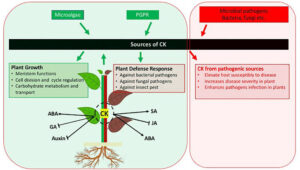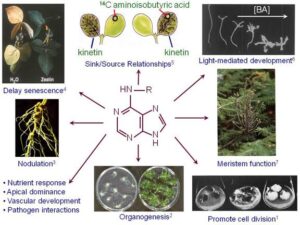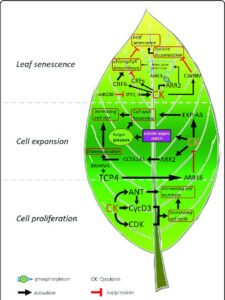Back to: Botany 200 Level
Hello, brilliant learner! Have you ever wondered how farmers get bigger fruits, taller plants, or fresher vegetables? Or how some plants flower earlier than others? The secret lies in the use of plant hormones like gibberellins and cytokinins in agriculture!
Today, we’ll learn about the agricultural applications of gibberellins and cytokinins—how they help farmers improve crop growth, yield, and quality.
Agricultural applications of gibberellins and cytokinins
How Are Plant Hormones Used in Agriculture?
Gibberellins and cytokinins are widely used in farming, horticulture, and plant research. They help in:

✅ Increasing plant growth – Making plants taller and healthier.
✅ Promoting fruit and seed development – Producing bigger and better fruits.
✅ Delaying ageing – Keeping vegetables and fruits fresh for longer.
✅ Breaking dormancy – Making seeds germinate faster.
Let’s look at how each hormone is used.
1. Agricultural Applications of Gibberellins
Gibberellins (GAs) are used to enhance plant growth and reproduction in several ways.
(a) Increasing Fruit Size
Farmers use gibberellins to increase fruit size in crops like:
✔ Grapes – Gibberellins help in making grapes grow larger and seedless.
✔ Apples and pears – They improve fruit shape and size.
(b) Breaking Seed Dormancy
Some seeds take a long time to germinate. Gibberellins help seeds sprout faster by stimulating enzymes that break down stored food.

✔ Example: Barley seeds are treated with gibberellins in breweries to speed up germination for malt production.
(c) Stimulating Stem Growth
✔ Used in sugarcane farming to make stems grow taller, leading to higher sugar production.
✔ Helps in rice farming by promoting uniform growth.
(d) Inducing Flowering
✔ Some plants require gibberellins to flower, especially those in cold climates.
✔ Example: Used in pineapple farms to induce early flowering for faster harvest.
2. Agricultural Applications of Cytokinins
Cytokinins are mainly used to promote cell division, delay ageing, and improve crop yield.
(a) Delaying Ageing (Senescence)
Cytokinins slow down the yellowing of leaves and fruits, keeping them fresh for longer.
✔ Example: Used to keep cabbage, lettuce, and spinach fresh after harvesting.
(b) Promoting Shoot and Bud Growth
Cytokinins help stimulate new shoots and side branches, leading to bushier plants.

✔ Used in tissue culture to produce multiple plants from a single cell.
(c) Improving Crop Yield
✔ Cytokinins help plants transport nutrients more efficiently, leading to bigger and healthier crops.
✔ Example: In wheat farming, cytokinins increase grain yield by enhancing nutrient movement.
Why Are Gibberellins and Cytokinins Important in Farming?
✔ Increase crop yield – Bigger fruits, more grains, and healthier plants.
✔ Reduce waste – Fruits and vegetables stay fresh longer.
✔ Speed up germination – Faster seed growth and early flowering.
✔ Improve plant structure – Stronger and taller stems, more branches.
Summary
Gibberellins help in fruit enlargement, seed germination, stem elongation, and flowering.
Cytokinins promote cell division, delay ageing, stimulate shoot growth, and improve crop yield.
Farmers use these hormones to enhance food production, improve fruit quality, and extend shelf life.
Let’s Test Your Understanding:
- How do gibberellins help in increasing fruit size?
- Why do farmers use cytokinins on leafy vegetables?
- How are gibberellins used in the sugarcane industry?
Great job, superstar! Now you know how plant hormones are used in farming to grow better crops. Keep learning, and see you in the next lesson!
